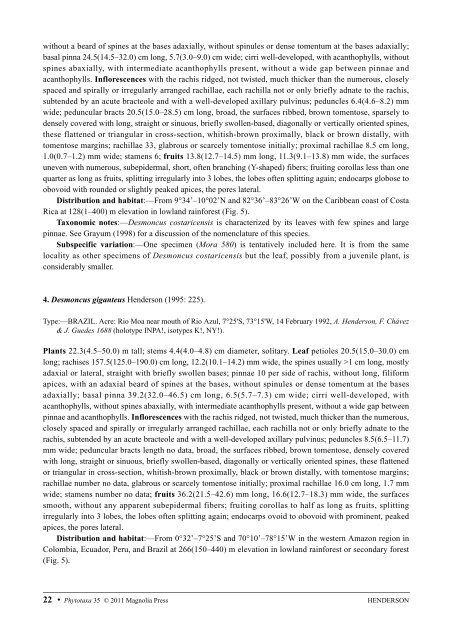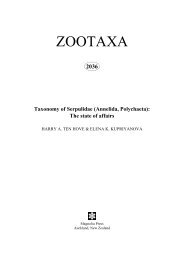Create successful ePaper yourself
Turn your PDF publications into a flip-book with our unique Google optimized e-Paper software.
without a beard of spines at the bases adaxially, without spinules or dense tomentum at the bases adaxially;<br />
basal pinna 24.5(14.5–32.0) cm long, 5.7(3.0–9.0) cm wide; cirri well-developed, with acanthophylls, without<br />
spines abaxially, with intermediate acanthophylls present, without a wide gap between pinnae and<br />
acanthophylls. Inflorescences with the rachis ridged, not twisted, much thicker than the numerous, closely<br />
spaced and spirally or irregularly arranged rachillae, each rachilla not or only briefly adnate to the rachis,<br />
subtended by an acute bracteole and with a well-developed axillary pulvinus; peduncles 6.4(4.6–8.2) mm<br />
wide; peduncular bracts 20.5(15.0–28.5) cm long, broad, the surfaces ribbed, brown tomentose, sparsely to<br />
densely covered with long, straight or sinuous, briefly swollen-based, diagonally or vertically oriented spines,<br />
these flattened or triangular in cross-section, whitish-brown proximally, black or brown distally, with<br />
tomentose margins; rachillae 33, glabrous or scarcely tomentose initially; proximal rachillae 8.5 cm long,<br />
1.0(0.7–1.2) mm wide; stamens 6; fruits 13.8(12.7–14.5) mm long, 11.3(9.1–13.8) mm wide, the surfaces<br />
uneven with numerous, subepidermal, short, often branching (Y-shaped) fibers; fruiting corollas less than one<br />
quarter as long as fruits, splitting irregularly into 3 lobes, the lobes often splitting again; endocarps globose to<br />
obovoid with rounded or slightly peaked apices, the pores lateral.<br />
Distribution and habitat:—From 9°34’–10°02’N and 82°36’–83°26’W on the Caribbean coast of Costa<br />
Rica at 128(1–400) m elevation in lowland rainforest (Fig. 5).<br />
Taxonomic notes:—Desmoncus costaricensis is characterized by its leaves with few spines and large<br />
pinnae. See Grayum (1998) for a discussion of the nomenclature of this species.<br />
Subspecific variation:—One specimen (Mora 580) is tentatively included here. It is from the same<br />
locality as other specimens of Desmoncus costaricensis but the leaf, possibly from a juvenile plant, is<br />
considerably smaller.<br />
4. Desmoncus giganteus Henderson (1995: 225).<br />
Type:—BRAZIL. Acre: Rio Moa near mouth of Rio Azul, 7°25'S, 73°15'W, 14 February 1992, A. Henderson, F. Chávez<br />
& J. Guedes 1688 (holotype INPA!, isotypes K!, NY!).<br />
Plants 22.3(4.5–50.0) m tall; stems 4.4(4.0–4.8) cm diameter, solitary. Leaf petioles 20.5(15.0–30.0) cm<br />
long; rachises 157.5(125.0–190.0) cm long, 12.2(10.1–14.2) mm wide, the spines usually >1 cm long, mostly<br />
adaxial or lateral, straight with briefly swollen bases; pinnae 10 per side of rachis, without long, filiform<br />
apices, with an adaxial beard of spines at the bases, without spinules or dense tomentum at the bases<br />
adaxially; basal pinna 39.2(32.0–46.5) cm long, 6.5(5.7–7.3) cm wide; cirri well-developed, with<br />
acanthophylls, without spines abaxially, with intermediate acanthophylls present, without a wide gap between<br />
pinnae and acanthophylls. Inflorescences with the rachis ridged, not twisted, much thicker than the numerous,<br />
closely spaced and spirally or irregularly arranged rachillae, each rachilla not or only briefly adnate to the<br />
rachis, subtended by an acute bracteole and with a well-developed axillary pulvinus; peduncles 8.5(6.5–11.7)<br />
mm wide; peduncular bracts length no data, broad, the surfaces ribbed, brown tomentose, densely covered<br />
with long, straight or sinuous, briefly swollen-based, diagonally or vertically oriented spines, these flattened<br />
or triangular in cross-section, whitish-brown proximally, black or brown distally, with tomentose margins;<br />
rachillae number no data, glabrous or scarcely tomentose initially; proximal rachillae 16.0 cm long, 1.7 mm<br />
wide; stamens number no data; fruits 36.2(21.5–42.6) mm long, 16.6(12.7–18.3) mm wide, the surfaces<br />
smooth, without any apparent subepidermal fibers; fruiting corollas to half as long as fruits, splitting<br />
irregularly into 3 lobes, the lobes often splitting again; endocarps ovoid to obovoid with prominent, peaked<br />
apices, the pores lateral.<br />
Distribution and habitat:—From 0°32’–7°25’S and 70°10’–78°15’W in the western Amazon region in<br />
Colombia, Ecuador, Peru, and Brazil at 266(150–440) m elevation in lowland rainforest or secondary forest<br />
(Fig. 5).<br />
22 Phytotaxa 35 © 2011 <strong>Magnolia</strong> <strong>Press</strong><br />
HENDERSON
















